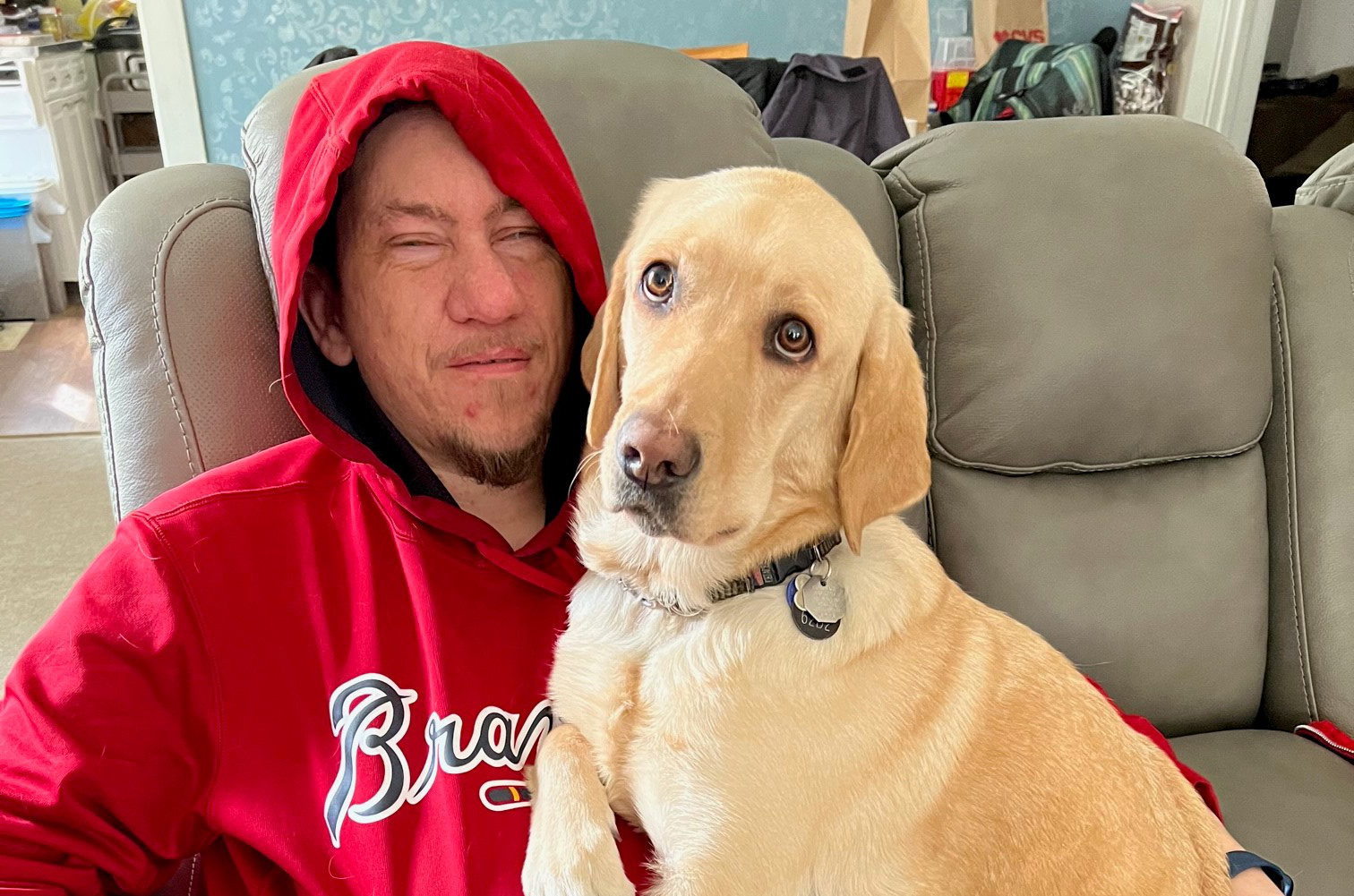My Perspective: Can I Pet Your Eyes

By Ed Worrell
Ed Worrell is co-founder of OverHere Consulting. Based in Great Falls, OverHere Consulting carries assistive technologies for vision impairment and provides training to individuals, schools, and government agencies. Ed is blind, diabetic, and loves helping the visually impaired utilize assistive technology. Ed is an accessibility tester for several apps.
I’ve been a dog guide handler for 10 years and have had the privilege of working with two of the best dogs in the world. They never talk back and are always willing to listen, but even more than that, they have been my travel companions. The vital role they play in helping me travel independently cannot be overestimated.
Here are some of the most common questions I get asked when I’m out working with my dog guide, Helen.
Q: What does Helen do for you?
A: Helen is my eyes. I’m blind, and she sees for me. She helps me walk down the street, find doors, and guide me to the office. You should never pet a working dog. So, please do not pet my eyes when we are en route.
Q: What is the thing on her back?
A: Helen is like Superwoman, and this is her cape. With this, Helen gets me everywhere. Without it, she’s just a dog. The harness handle gives me feedback, such as pushing or pulling me away from an obstacle. It also is rigid so I can feel when Helen stops at a down curb or steps up onto a curb.
Q: Does Helen help you in getting around the house?
A: When I walk in the front door, Helen’s super cape/harness comes off. She doesn’t guide me around the house but often stays right by my side. She likes to get pets, snuggle and chase her toy around the living room. At home, she likes to relax the same way we do: sitting down with a snack and watching The Big Bang Theory.
Q: Were you afraid before you had Helen?
A: Sure, sometimes it was scary getting around before I had a guide dog. Helen gives me a partner to share in the fun. I can almost hear Helen pipe up with, “No problem, Guy, I got this!” Walking with her gives me so much more confidence. We move through the world much quicker and safer than with my white cane.
Q: Since Helen is a working dog, can she go anywhere?
A: Yes. We can do it all: cars, ride-sharing, public transit, airplanes, etc. Dog guides are allowed everywhere the general public can go. This is not true for all service animals. For example, therapy dogs and emotional support animals do not have the same legal access to public spaces that guide dogs have. Guide dogs are a very small and special group of well-trained animals.
In recent years, more people are bringing pet dogs into public spaces, which is problematic for handlers and their guides. Please do not bring your pet dog into places such as grocery stores, restaurants, malls, etc. This could be a dangerous distraction to me and my highly trained guide dog.
Q: How did you get around before you had a dog?
A: I used a white mobility cane, but it took me a while to feel comfortable with it. I didn’t want to look different. Now, I realize that having Helen or using a white cane is what makes me unique. Before I had a guide dog, I felt as if the world was staring at me using my white cane. In fact, more people watch me with Helen, as we are a sight to behold when we are working a route or in a business. Our movement is fluid and we work as a team.
Q: Did you name her Helen?
A: Nah, Helen’s guide dog school, Guide Dogs for the Blind, named her. It’s important for the dogs to know their names from the start. Dog guide handlers often give their dogs nicknames after working with them for a while.
Public Service Announcement:
Petting a guide dog while it’s working would be kind of like me asking to pet your eyes. I’m pretty sure you wouldn’t like my dog-slobbery, kibble-scented fingers rooting around your eyes. And remember to ask before you pet a service animal; don’t assume that the dog handler is ok with you “just saying hi!”.
Learn from experienced Montana handlers by visiting the Montana Dog Guide Group on Facebook:
Disclaimer:
This publication was developed under Grant H84MC32752 from the Health Resources and Services Administration (HRSA), Family to Family Health Information Center, $96,750. Views and opinions expressed in this article are the author’s and do not necessarily reflect the official policy or position of the Montana Family to Family Health Information Center, the Rural Institute for Inclusive Communities, the University of Montana, or HRSA.
Suggested citation:
Worrell, E. (2022, November). My Perspective: Can I Pet Your Eyes? The Montana Family to Family Health Information Center. Retrieved from Montana Family to Family
Montana Voices Amplified:
The Montana Voices Amplified project offers people of all ages and abilities a stage to speak for themselves. The series is hosted by the Montana Family to Family Health Information Center (MT F2F), a program of the Rural Institute for Inclusive Communities (RIIC) at the University of Montana.
Montana Voices Amplified provides a microphone and broad audience so the stories, lessons, causes, and advice of individuals with disabilities and their families are heard.
Montana Voices Amplified welcomes submissions of five-minute videos or 600-700-word essays on any topic related to your lived experience as a person with a disability or caring for someone with a disability.
Authors of chosen submissions receive $100. Videos will be posted on the MT F2F website and shared on social media. Essays will be posted on the website and ScholarWorks, shared on social media, and printed in a professionally designed publication to distribute to families, schools, agencies, and legislators as appropriate.
Let us amplify YOUR voice!
Send your idea for an article or brief video to stacey.bliss@mso.umt.edu or shawna.hanson@mso.umt.edu.
If you prefer to talk through your idea, you can call Shawna at (406) 243-4531 or Stacey at (406) 243-5760.

